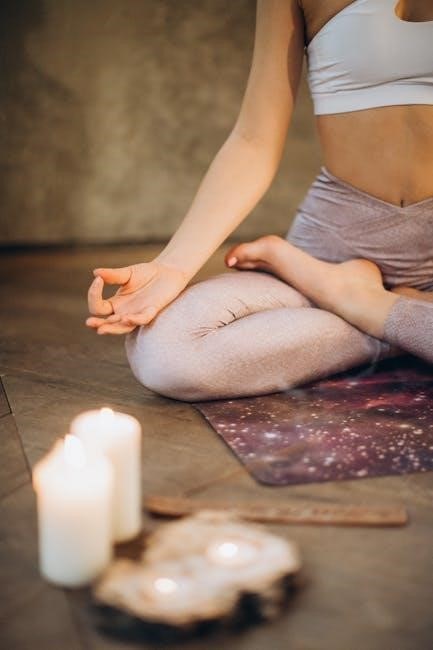Yoga is a holistic practice combining physical postures, breathing techniques, and meditation to enhance overall well-being. Perfect for newcomers, it promotes strength, flexibility, and balance while fostering mindfulness.
A well-structured yoga sequence for beginners provides a foundation for understanding poses and breathwork, offering a transformative experience that nurtures both body and mind from the very first session.
What is Yoga?
Yoga is an ancient holistic practice that integrates physical postures, breathing techniques, and meditation to promote physical, mental, and spiritual well-being. Originating in India, it has evolved into a global phenomenon, offering a pathway to balance and harmony in life.
At its core, yoga is about unity—uniting the body, mind, and spirit through mindful movements and breath awareness. It is accessible to everyone, regardless of age or fitness level, making it an ideal practice for beginners seeking to cultivate strength, flexibility, and inner peace.
Benefits of Yoga for Beginners
Yoga offers numerous benefits for beginners, including improved flexibility, strength, and balance. It enhances physical health while reducing stress and anxiety, promoting mental clarity and emotional well-being. Regular practice fosters mindfulness and self-awareness, helping individuals connect with their bodies and minds on a deeper level.
For those new to yoga, it provides a gentle yet effective way to build confidence and establish a healthy routine. The holistic approach of yoga ensures that beginners experience overall wellness, making it an ideal practice for those seeking to improve their quality of life from day one.
Why Yoga is Perfect for Beginners
Yoga is an accessible and adaptable practice, making it ideal for beginners. It requires no prior experience or special equipment, allowing anyone to start their journey. The focus on breath and movement creates a calming atmosphere, helping newcomers feel comfortable and centered. Yoga sequences for beginners are designed to be simple yet effective, introducing foundational poses and breathing techniques that build confidence and strength gradually. This holistic practice also fosters mindfulness and self-awareness, providing a sense of accomplishment and well-being from the very first session.
Whether you’re seeking physical fitness, mental relaxation, or emotional balance, yoga offers a nurturing environment for growth and transformation. Its gentle pace and emphasis on listening to your body make it a perfect starting point for anyone looking to embrace a healthier lifestyle. With yoga, beginners can experience the joy of connecting with their bodies and minds in a way that feels both challenging and rewarding.
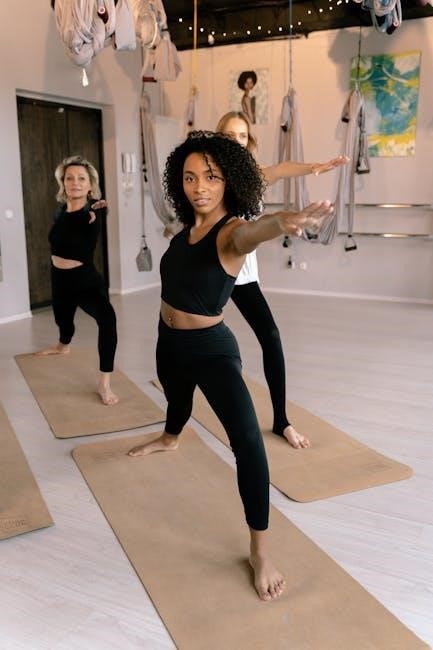
Essential Elements of a Yoga Sequence
A yoga sequence combines physical postures, breathing techniques, and meditation to create a balanced practice. It starts with warm-ups, progresses to peak poses, and ends with relaxation, promoting harmony and well-being.
Understanding Yoga Poses (Asanas)
Yoga poses, or asanas, form the foundation of a yoga practice. They are designed to promote physical alignment, strength, flexibility, and balance. For beginners, mastering basic asanas like Mountain Pose and Downward-Facing Dog is essential. These poses help build awareness of the body and prepare it for more complex movements. Proper alignment and breath synchronization are key to deriving maximum benefits. Asanas also improve circulation, reduce stiffness, and enhance overall well-being. Starting with simple poses allows beginners to gradually progress, ensuring a safe and enjoyable practice. Regular practice of these foundational asanas lays the groundwork for a lifelong yoga journey.
Importance of Breathing Techniques (Pranayama)
Breathing techniques, or pranayama, are a cornerstone of yoga, linking the body and mind. Techniques like Ujjayi and Nadi Shodhana help calm the nervous system, enhance focus, and prepare the body for poses. These practices improve oxygen flow, boost energy, and reduce stress. For beginners, incorporating pranayama into their sequence fosters mindfulness and deepens their practice. Regular breathing exercises also promote relaxation and mental clarity, making them an essential part of a balanced yoga routine. They enhance overall well-being and create a meditative state, complementing the physical benefits of asanas for a holistic experience.
How to Structure a Beginner-Friendly Sequence
A beginner-friendly yoga sequence should start with centering and warm-ups to prepare the body and mind. Begin with foundational poses like Mountain Pose and Cat-Cow to establish alignment and flexibility. Incorporate breathing techniques to enhance focus and relaxation. Progress to gentle flows, such as Sun Salutations, linking movement with breath for a smooth transition. Include a peak pose to challenge yet not overwhelm, followed by cooling stretches and relaxation. End with Savasana or gratitude practice to seal the session. Keep the flow dynamic yet accessible, using props for support and ensuring modifications are offered to suit all levels and prevent injury.
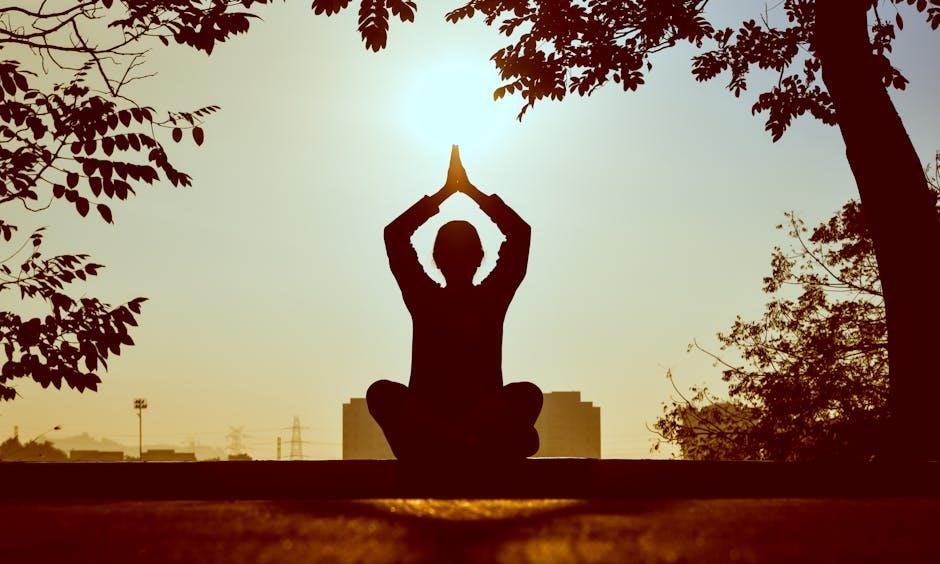
Preparation for Your First Yoga Practice
Begin by selecting a quiet, clutter-free space and gathering essential props like a mat, blocks, and a bolster. Set realistic goals and dress comfortably for ease of movement, ensuring a distraction-free environment to foster focus and relaxation during your session.
Choosing the Right Equipment: Mats, Blocks, and Bolsters
A good yoga mat provides grip and cushioning, essential for stability and comfort. Blocks and bolsters are valuable props, especially for beginners, as they help modify poses to suit your flexibility and strength levels. Blocks can bridge the gap between the floor and your hands in standing poses, while bolsters support your body in seated or reclined positions, promoting relaxation and proper alignment. Investing in high-quality equipment ensures a safe and enjoyable practice, allowing you to focus on your breathing and movements without discomfort or strain.
Creating a Safe and Comfortable Practice Space
A quiet, clutter-free area with a smooth floor is ideal for yoga. Ensure good lighting and a comfortable temperature to enhance focus and relaxation. Place your mat in the center of the room, away from drafts. Keep the space clean and free from distractions, promoting a calm atmosphere. Consider using pillows or blankets for added comfort during seated or lying poses. A mirror can help check alignment, while soothing music or nature sounds can deepen your practice experience. A well-prepared space fosters mindfulness and makes your yoga journey more enjoyable and effective.
Setting Realistic Goals for Your Yoga Journey
Setting realistic goals helps you stay motivated and committed to your yoga practice. Begin with short, manageable sessions, such as 10–15 minutes daily, and gradually increase as you build comfort and confidence. Focus on consistency rather than perfection, celebrating small achievements like mastering a pose or improving flexibility.
Listen to your body and set intentions that align with your personal needs, whether it’s improving physical health, reducing stress, or enhancing mental clarity. This approach ensures a balanced and enjoyable journey, fostering progress and mindfulness at every step.

Basic Yoga Poses for Beginners
Master essential poses like Mountain Pose, Downward-Facing Dog, Cat-Cow, Cobra, and Child’s Pose. These foundational asanas promote strength, flexibility, and mindfulness, ideal for starting your yoga journey.
Mountain Pose (Tadasana)
Mountain Pose, or Tadasana, is a foundational standing pose that establishes good posture and balance. It engages the entire body, improving alignment and stability. To practice, stand tall with feet hip-width apart, arms by your sides, and palms facing forward. Engage your core, relax your shoulders, and gaze forward. Breathe naturally, holding for 3-5 breaths. This pose strengthens the legs, enhances posture, and prepares the body for other asanas. It’s an excellent starting point for beginners, promoting body awareness and grounding. Regular practice helps build confidence and sets the foundation for a strong yoga sequence.
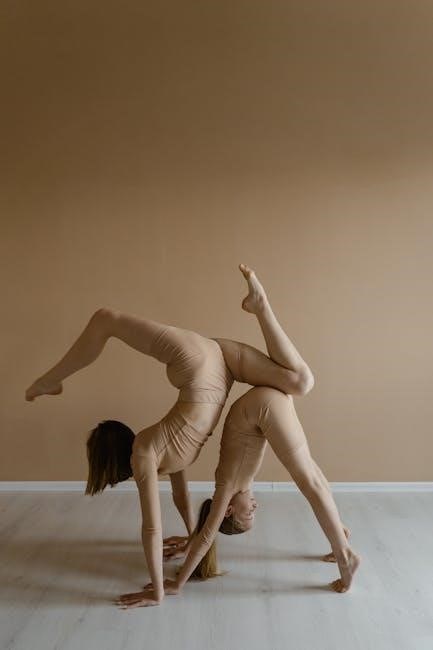
Downward-Facing Dog (Adho Mukha Svanasana)
Downward-Facing Dog, or Adho Mukha Svanasana, is a foundational pose that stretches the hamstrings, calves, and spine while strengthening the arms and shoulders. Start on all fours, then lift your hips, straightening your arms and legs, and form an inverted V shape. Keep your head in a neutral position and engage your core. Hold for 3-5 breaths. This pose energizes the body and prepares it for more dynamic sequences. For beginners, using blocks under the hands or slightly bending the knees can make the pose more accessible. Proper alignment is key to avoid strain and maximize benefits.
Cat-Cow Pose (Marjaryasana-Bitilasana)
Cat-Cow Pose is a gentle sequence that warms up the spine, improving flexibility and relieving tension. Start on all fours. Inhale and arch your back, lifting your head and tailbone (Cow Pose). Exhale and round your spine, tucking your chin and pelvis (Cat Pose). Repeat several times, syncing movement with breath. This pose is excellent for beginners, as it introduces the concept of linking breath with motion. It’s also a great preparation for more complex sequences and helps maintain a healthy back. Regular practice enhances posture and reduces stress effectively.
Cobra Pose (Bhujangasana)
Cobra Pose strengthens the back muscles, improves posture, and opens the chest. Lie on your stomach with hands under your shoulders. Inhale and press your palms into the ground, lifting your chest and head off the mat. Keep your shoulders down and neck neutral. Hold for a few breaths, then exhale and lower back down. This pose is great for beginners, as it builds confidence and prepares the body for more advanced backbends. Regular practice can enhance spinal flexibility and reduce upper body tension, promoting a strong and open upper body structure.
Child’s Pose (Balasana)
Child’s Pose is a gentle, resting pose that stretches the back, hips, and legs while promoting relaxation. Knees wide, sit back onto your heels, and stretch your arms forward, lowering your forehead to the ground. Breathe deeply, feeling calm and grounded. This pose is ideal for beginners, as it provides a moment of rest and rejuvenation. Regular practice can improve flexibility, reduce tension, and prepare the body for more dynamic poses. It’s a perfect way to slow down and connect with your breath, making it a cornerstone in any yoga sequence for stress relief and mindfulness.
Beginner-Friendly Yoga Sequences
Beginner-friendly yoga sequences are crafted for new practitioners, combining foundational poses to enhance strength, balance, and flexibility while fostering mindfulness and relaxation through gradual, accessible movements.
Morning Yoga Routine for Energy and Flexibility
A morning yoga routine is an excellent way to boost energy and kickstart your day. Begin with gentle Sun Salutations to warm up, then transition into foundational poses like Mountain Pose, Downward-Facing Dog, and Cobra Pose to awaken your body. Incorporate Cat-Cow Pose to enhance spinal flexibility and improve circulation. End with Child’s Pose to relax and center your mind. This sequence is designed to gradually increase energy levels while improving flexibility, preparing you for the day ahead with a sense of balance and vitality;
Evening Yoga Routine for Relaxation and Stress Relief
An evening yoga routine is perfect for unwinding and preparing your body for rest. Begin with gentle stretches like Seated Forward Fold to release tension in the hamstrings and lower back. Transition into calming poses such as Child’s Pose and Cat-Cow Pose to soothe the spine and promote relaxation. Incorporate Legs-Up-The-Wall Pose to calm the nervous system and improve circulation. End with Deep Breathing exercises or Savasana to quiet the mind and rejuvenate your body. This sequence helps alleviate stress, fosters mental calm, and prepares you for a restful night’s sleep.
Short Yoga Sequence for Busy Days
A short yoga sequence is ideal for busy days, offering a quick yet effective way to refresh and recharge. Start with Mountain Pose to ground yourself, followed by a round of Sun Salutations to energize the body. Transition into Cat-Cow Pose to loosen the spine and improve flexibility. Move into Downward-Facing Dog for a full-body stretch, then rest in Child’s Pose to relax. End with Seated Forward Fold to calm the mind and a brief Plank Pose to build strength. Conclude with a short Savasana and deep breathing to rejuvenate. This sequence balances energy and relaxation, perfect for tight schedules.
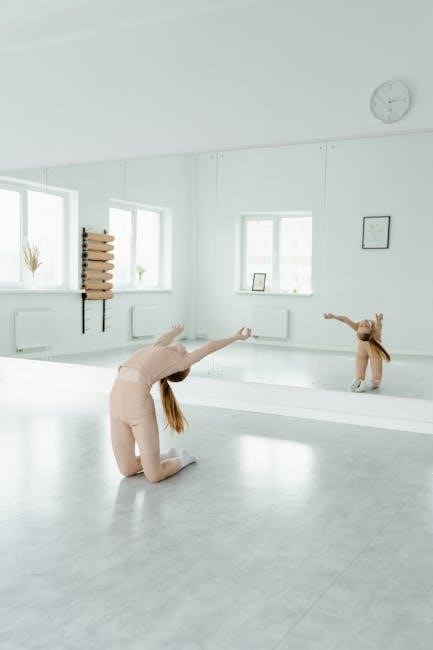
Breathing Techniques for Beginners
Mastering basic breathing techniques enhances yoga practice by improving focus, relaxation, and energy flow. Techniques like Ujjayi and Nadi Shodhana are simple yet transformative for newcomers.
Ujjayi Breath (Ocean Breath)
Ujjayi, or Ocean Breath, is a foundational breathing technique that calms the mind and regulates breath. It is practiced by inhaling and exhaling through the nose with a slight constriction in the throat, creating a soft “ocean” sound.
This technique promotes relaxation, improves focus, and prepares the body for meditation. It is especially beneficial during yoga sequences as it helps maintain a steady rhythm and enhances the connection between breath and movement.
Nadi Shodhana (Alternate Nostril Breathing)
Nadi Shodhana, or Alternate Nostril Breathing, is a powerful technique that balances the nervous system and harmonizes the breath. It involves closing one nostril with the thumb or pinky finger, inhaling through the other, then switching to exhale. This practice is said to purify the energy channels and prepare the mind for meditation.
Regular practice of Nadi Shodhana reduces stress, improves respiratory function, and enhances mental clarity. It is often included in yoga sequences for beginners to promote relaxation and create a calm, focused state, making it easier to transition into other poses and breathing exercises.
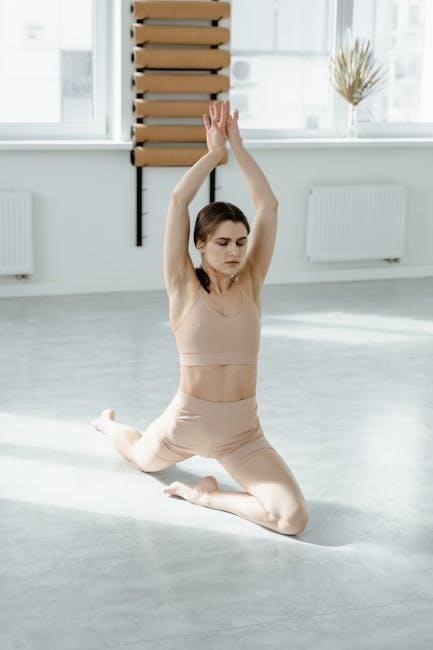
Bhramari Breath (Bee Breath)
Bhramari Breath, or Bee Breath, is a calming yoga technique that mimics the sound of a humming bee. It involves inhaling deeply, then exhaling slowly while making a soft humming noise. This practice is known to reduce stress, lower blood pressure, and promote relaxation by soothing the nervous system.
Regular practice of Bhramari Breath enhances focus, calms the mind, and prepares the body for meditation. It is often incorporated into yoga sequences for beginners to create a peaceful atmosphere, helping practitioners connect with their breath and find inner balance before moving into physical postures or more complex breathing exercises.

Common Mistakes to Avoid
Forcing poses beyond comfort, ignoring proper alignment, and not listening to your body are common mistakes that can lead to injury or an ineffective practice.
Overstretching and Injury Prevention
Overstretching is a common mistake among beginners, often leading to muscle strain or injury. To prevent this, focus on gradual progression and honor your body’s limits. Use props like blocks or straps to modify poses and maintain safe alignment. Prioritize controlled movements over deep stretches, especially in the early stages. Listening to your body and resting when needed is crucial. Avoid pushing past pain, as yoga should never cause discomfort. Proper warm-ups and breathing techniques can also help prepare the body for practice, reducing the risk of injury and enhancing overall safety during your yoga sequence.
Ignoring Proper Alignment
Ignoring proper alignment can lead to ineffective poses and potential injuries. Many beginners prioritize flexibility over form, compromising their practice. It’s essential to focus on precise positioning to ensure safety and maximize benefits. For example, in downward-facing dog, keeping the hips lifted and palms grounded prevents rounding in the shoulders. Using props like blocks can help maintain proper alignment when flexibility is limited. Always follow instructor guidance or visual cues to avoid common mistakes. Prioritizing alignment over depth ensures a safe and effective yoga practice, allowing you to progress gradually and mindfully.
Not Listening to Your Body
Not listening to your body is a common mistake that can hinder progress and lead to injuries. Yoga is not a competition; it’s a personal journey. Ignoring physical limitations or pushing too hard can result in strains or chronic issues. Honor your body’s signals and take rest when needed. Forcing into poses can create imbalances and undermine the practice’s benefits.
Be mindful of discomfort and modify poses as necessary. Prioritize sustainability over intensity to cultivate a safe and enjoyable practice. Remember, yoga is about harmony, not strain, ensuring long-term well-being and growth.
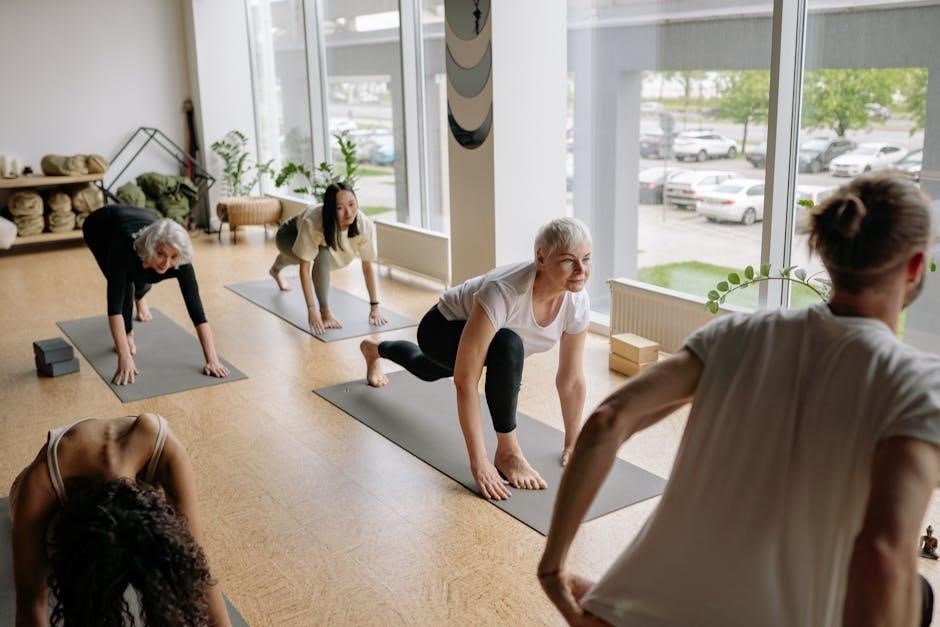
Modifications for Different Fitness Levels
Yoga sequences for beginners can be adapted using props like blocks and bolsters to make postures accessible. Modifications ensure poses suit individual flexibility and strength levels, promoting safety and comfort during practice.
Using Props for Support
Props like yoga blocks, bolsters, and straps are essential for making poses accessible and comfortable. Blocks can bridge the gap between the ground and your hands in standing poses, while bolsters provide support for seated postures or under the knees in restorative poses. Straps help deepen stretches or maintain proper alignment when flexibility is limited. These tools are particularly useful for beginners or those with tight muscles, ensuring safe and effective practice. By incorporating props, you can modify poses to suit your needs, enhancing your yoga experience without risking injury or discomfort.
Adjusting Poses for Flexibility and Strength
Yoga poses can be modified to suit different levels of flexibility and strength. For example, bending the knees slightly in standing poses or using a block under the hands in downward-facing dog can make the pose more accessible. As you progress, you can gradually deepen stretches or hold poses longer to build strength. Listening to your body and honoring its limits is key. By adjusting poses thoughtfully, you can tailor your practice to enhance flexibility and strength while maintaining safe alignment and preventing strain.
Modifying for Injuries or Chronic Pain
For those with injuries or chronic pain, yoga can be safely adapted to accommodate physical limitations. Using props like bolsters, blocks, or blankets provides support and reduces strain on sensitive areas. Gentle modifications, such as avoiding deep twists or substituting challenging poses with restorative alternatives, allow for a therapeutic experience. Additionally, practicing yoga while seated or using a wall for stability can help maintain alignment and comfort. By prioritizing modifications, individuals can enjoy the benefits of yoga without exacerbating their condition, fostering a healing and empowering practice tailored to their unique needs and abilities.
Yoga enhances health and wellness, fostering strength, flexibility, and mindfulness. Consistency is key to progress. Embrace your journey and enjoy the transformative power of yoga.
Final Tips for Consistency and Progress
To maintain consistency, set aside a specific time each day for yoga. Start with short sessions and gradually increase as your body adapts. Use props like blocks and bolsters to support your practice and prevent injuries. Listen to your body and rest when needed. Incorporate breathing techniques, such as Ujjayi and Nadi Shodhana, to enhance your practice. Stay patient and celebrate small milestones, as progress in yoga is a journey, not a race. Embrace mindfulness and enjoy the holistic benefits of yoga for both body and mind.
Encouragement to Continue Your Yoga Journey
Embrace yoga as a lifelong journey, celebrating small victories along the way. Each practice is a step toward greater strength, flexibility, and mindfulness. Remember, progress is personal and takes time. Be kind to yourself and honor your unique path. The holistic benefits of yoga extend beyond the mat, enriching your overall well-being and mental clarity. Stay committed, and you’ll find joy in the transformative power of this ancient practice.
Keep exploring, learning, and growing. Your dedication will unlock new possibilities, fostering a deeper connection with your body and mind. Namaste.
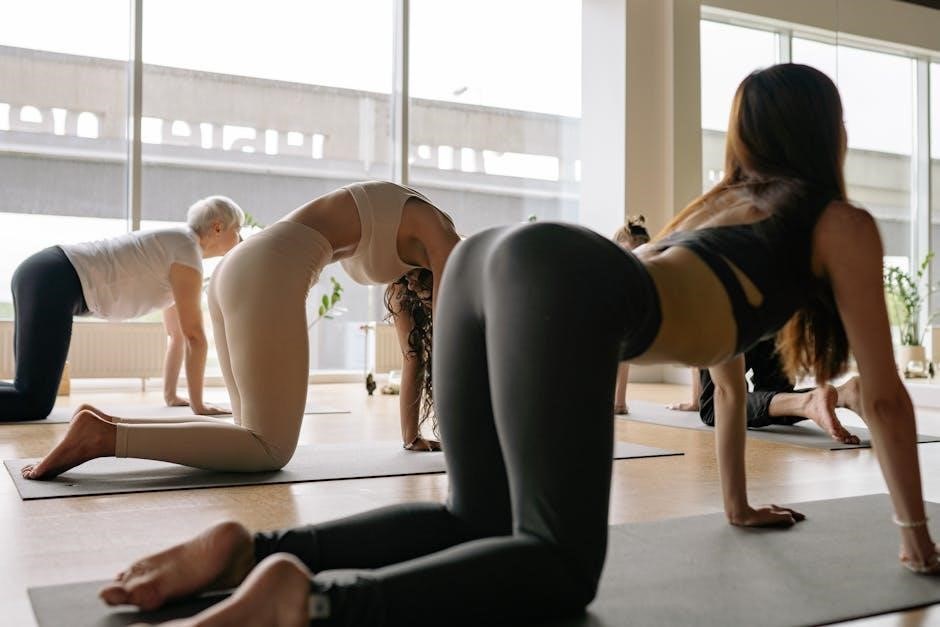
Additional Resources
Explore PDF guides, yoga apps, and online communities for beginner-friendly sequences. These resources offer step-by-step poses, video tutorials, and expert tips to enhance your practice and understanding.
- Downloadable PDF guides with detailed sequences.
- Top-rated yoga apps for home practice.
- Join supportive online forums for motivation and advice.
Recommended PDF Guides for Beginners
A comprehensive PDF guide like “Yoga Guide for Beginners: 101 Poses and Sequences for Strength, Flexibility, and Mindfulness” by Melody White is an excellent starting point. It features detailed instructions, HD images, and step-by-step sequences tailored for newcomers. The guide emphasizes safety, proper alignment, and breathing techniques, ensuring a smooth transition into yoga. Perfect for home practice, it includes modifications for different fitness levels and tips for tracking progress. Author Melody White’s expertise provides reassurance and clarity, making it a must-have resource for anyone beginning their yoga journey.
Best Yoga Apps for Home Practice
Discover the top yoga apps designed to enhance your home practice. These apps offer guided sessions, customizable routines, and tracking tools to monitor progress. Perfect for beginners, they provide clear instructions and modifications for poses. Features include timers, video tutorials, and calming music to create a serene atmosphere. Many apps are free or low-cost, making them accessible for everyone. They cater to various goals, from stress relief to weight loss, ensuring a holistic yoga experience. Download these apps to transform your home into a yoga studio and enjoy the benefits of yoga anytime, anywhere.
Online Communities and Forums for Support
Joining online yoga communities and forums connects you with like-minded practitioners, offering invaluable support and guidance. These platforms foster shared experiences, allowing beginners to ask questions, gain insights, and learn from others. Many communities provide resources, such as beginner-friendly sequences and pose modifications, to enhance your practice. They also serve as motivation, helping you stay consistent and inspired on your yoga journey.
Engaging with these groups can deepen your understanding of yoga and provide a sense of belonging. Whether troubleshooting poses or celebrating milestones, online communities are a powerful tool for growth and connection in your yoga practice.
